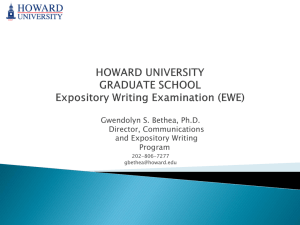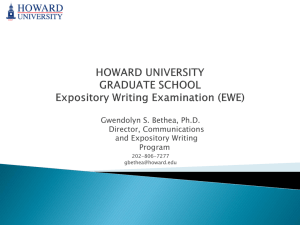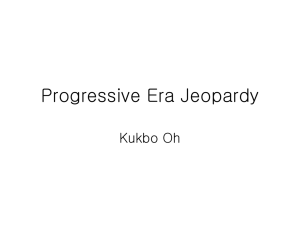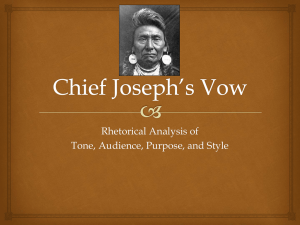View/Open - YorkSpace
advertisement
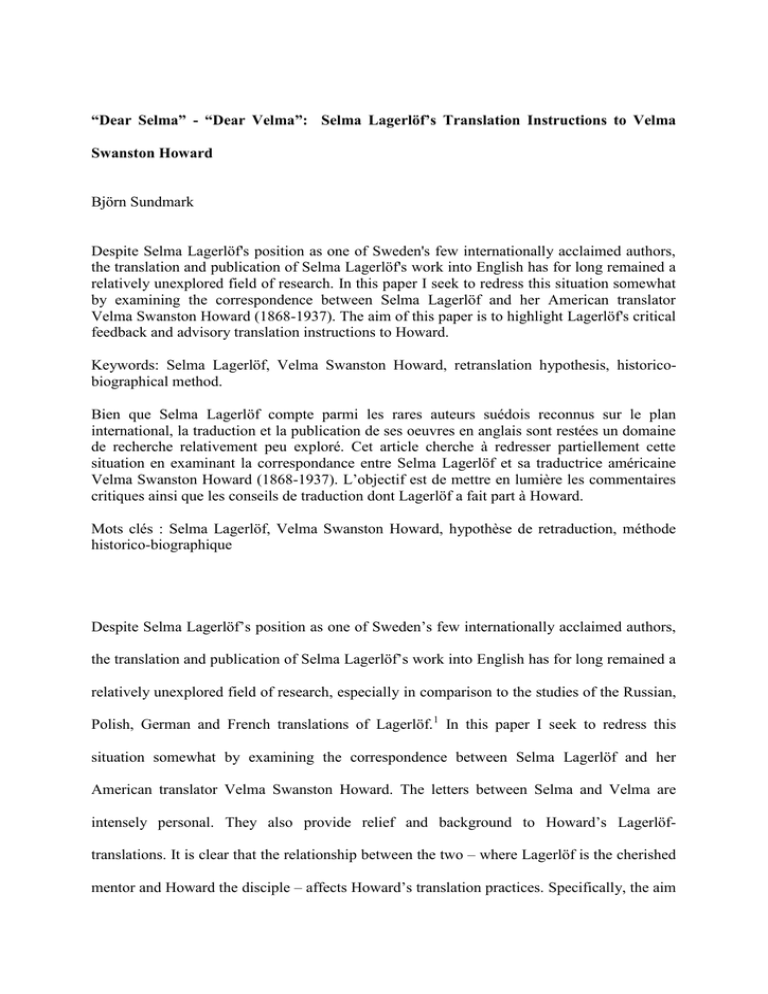
“Dear Selma” - “Dear Velma”: Selma Lagerlöf’s Translation Instructions to Velma Swanston Howard Björn Sundmark Despite Selma Lagerlöf's position as one of Sweden's few internationally acclaimed authors, the translation and publication of Selma Lagerlöf's work into English has for long remained a relatively unexplored field of research. In this paper I seek to redress this situation somewhat by examining the correspondence between Selma Lagerlöf and her American translator Velma Swanston Howard (1868-1937). The aim of this paper is to highlight Lagerlöf's critical feedback and advisory translation instructions to Howard. Keywords: Selma Lagerlöf, Velma Swanston Howard, retranslation hypothesis, historicobiographical method. Bien que Selma Lagerlöf compte parmi les rares auteurs suédois reconnus sur le plan international, la traduction et la publication de ses oeuvres en anglais sont restées un domaine de recherche relativement peu exploré. Cet article cherche à redresser partiellement cette situation en examinant la correspondance entre Selma Lagerlöf et sa traductrice américaine Velma Swanston Howard (1868-1937). L’objectif est de mettre en lumière les commentaires critiques ainsi que les conseils de traduction dont Lagerlöf a fait part à Howard. Mots clés : Selma Lagerlöf, Velma Swanston Howard, hypothèse de retraduction, méthode historico-biographique Despite Selma Lagerlöf’s position as one of Sweden’s few internationally acclaimed authors, the translation and publication of Selma Lagerlöf’s work into English has for long remained a relatively unexplored field of research, especially in comparison to the studies of the Russian, Polish, German and French translations of Lagerlöf.1 In this paper I seek to redress this situation somewhat by examining the correspondence between Selma Lagerlöf and her American translator Velma Swanston Howard. The letters between Selma and Velma are intensely personal. They also provide relief and background to Howard’s Lagerlöftranslations. It is clear that the relationship between the two – where Lagerlöf is the cherished mentor and Howard the disciple – affects Howard’s translation practices. Specifically, the aim of this paper is to highlight Lagerlöf’s critical feedback and advisory translation instructions to Howard. Velma Swanston Howard (1868-1937) is the chief translator of Selma Lagerlöf’s work into English – Jerusalem I-II, The Emperor of Portugallia and The Wonderful Adventures of Nils, to name some of the more important ones. Even today, when you come across Lagerlöf in English, it is likely that it will be an abridged or edited version based on Howard’s work. She was also a North American mouthpiece for Lagerlöf’s radical ideas concerning women’s voting rights and pacifism and an untiring promoter of Lagerlöf’s work.2 Howard’s identification with Lagerlöf was close; in a letter dated 12 August 1908 she writes to Lagerlöf: It is nearly two years now that I have done little else than working on your matter, and it is small wonder that at times I do not know whether I am you or myself! I played a dramatic role once which so completely possessed me that I had to give it up. I am so sensitive I have to guard against the danger of absorption. People think I have a strong personality – but I haven’t – only strong sympathies.3 Moreover, Howard translated Strindberg,4 and introduced Ibsen, as an actor and producer, to an American audience in a period when, as she phrases it in one letter to Lagerlöf, “only short-haired women and long-haired men would be seen at an Ibsen performance or lecture, now everyone goes.”5 Despite her impressive accomplishments as an American public intellectual of her time, Howard is all but forgotten today. The Corpus The extant correspondence between Selma Lagerlöf and Velma Swanston Howard is kept in the Royal Library in Stockholm. It consists of 427 letters from Howard to Lagerlöf. The earliest of these letters is from March 20,1905; the last is from December 8, 1936. There are 117 letters from Lagerlöf in the collection, spanning a shorter time period. The first of these is from February 8, 1914, and the last from October 28, 1936. Consequently, if we are looking for ‘authorial interventions’ during the first seven years of Howard’s and Lagerlöf’s acquaintance, it will have to be done by looking at Howard’s response to Lagerlöf’s letters, with much to be inferred and conjectured. But from 1914 we do get a more complete picture, even if it is likely that many of Lagerlöf’s letters to Howard have been lost. The texts Howard worked on during this later period were Jerusalem I-II (1915 and 1918), The Emperor of Portugallia (Kejsaren av Portugallien) (1916), the Löwensköld trilogy (1931)6 and the autobiographical books Mårbacka (1924), Memories of my Childhood (Ett barns memoarer) (1934) and The Diary of Selma Lagerlöf (Dagbok för Selma Ottilia Lovisa Lagerlöf) (1936), as well as shorter texts and new editions of older work. It should be noted that with one exception the letters from Howard to Lagerlöf are in English, while the letters from Lagerlöf are in Swedish. All translated quotations from Lagerlöf’s letters are mine; the original quotations are provided in the endnotes to this essay. Translation: A “Hanging” Matter? The letters show Howard as an energetic champion of Lagerlöf’s work and ideas. Sadly, however, Howard’s ability as a translator was not as great as her commitment and sincerity to the Lagerlöf cause in general. This is not the place for a linguistic and stylistic analysis of individual passages, but my impression is that Howard’s style is characterized by a certain flowery wordiness and a predilection for circumlocutions and archaisms that are quite alien to Lagerlöf’s effective and direct storytelling technique. Peter Graves, summarizing contemporary reviews of Lagerlöf translations into English, writes that with few exceptions “the translators are all found wanting, none more so than Velma Swanston Howard.”7 In Howard’s case, it has to do in part with British impatience with American English (incidentally, one wonders of course why the publisher did not take the trouble to remove Americanisms in a British edition), but that cannot be the whole story. Writing about a recent collection of Lagerlöf’s short stories, Steven Sondrup observes that “Velma Swanston Howard […] has taken some noticeable liberties with the text and her attempt to reproduce Lagerlof's characteristic style seems rather dated and fussy today.”8 Howard edited her translations a couple of times for new editions, but to no avail. Norvik press is currently (2011-2012) retranslating several Lagerlöf titles, but it is certainly curious that although Howard’s translations were criticized from the start, there have been so few initiatives to retranslate Lagerlöf’s work over the years. The argument that translations date more quickly than original texts and therefore provide a demand for retranslation (part of the Retranslation Hypothesis)9 is amply met in Howard’s case. It is also true that Howard tends towards domestication in her translations (another aspect of the Retranslation Hypothesis). Again, it would not have been surprising to see attempts to provide translations with greater fidelity to the source language and culture. So, why were Howard’s translations not replaced? My guess – and it cannot be more than speculation – is that Lagerlöf’s status in the English-speaking world was not high enough to ensure continued interest in her work. I also believe that the Retranslation Hypothesis should be modified in certain respects. For instance, it can be argued that great translations, just like great original works of art, stimulate new work (see Bloom’s theory of anxiety of influence). A great translation may have staying power, but it will also challenge new translators to do something different. A mediocre translation does not have the same replicating quality. A great many examples could be given, but this is outside the scope of this article. Suffice to say that Howard’s work did date quickly, and that – contrary to what one could have expected – it failed to inspire other translations. Occasionally, in her letters, Howard becomes defensive when her translations are criticised: [The British reviewer] jumped on my translation of “Nils Holgersson”! They had to admit, however, that the “quality of the original was well preserved, but that the book was overrun by American needs of speech,” whatever that may mean. When scholars like Eggleton & Hamilton & H[?] consider it clear and classical English, I’m not going to worry over the opinions of conventional English mutton-heads. Besides it will do them good to read something out of the ordinary. 10 But worry she did, and her rather chauvinistic counterstrike here is precisely a sign that she is apprehensive and unsure about her own qualifications. It is also characteristic that she seeks the support of male arbiters of taste and style (American academics, publishers, authors), who edit and sanction her writing. I am quite convinced that these same men, and of course Howard’s fear of failing, are to blame for Howard’s sometimes cramped style in the translations – a negative quality that is absent from her lively and direct letters. Howard’s fear of criticism also makes her unduly aggressive towards competitors, as in the following tirades about Jessie Brockner’s translation of Christ Legends: “Of your two former translators, Mrs. Flack’s work is by far the better. I’m simply appalled by Mrs. Brockner’s bungling work! I don’t understand how any publisher ever accepted it. It isn’t even English.”11 And another one: “Fortunately the book is out of print! It is shockingly translated, Selma! No wonder you did not get there as they say – I never read such English […] Some translators ought to be hanged for their crimes against authors!”12 In part, Howard’s anxiety also has to do with the uncertain situation of translators at that time. There was no copyright agreement between Sweden and America until 1910, which basically meant that anyone could translate anything without authorization. Howard, who sometimes benefited from this situation (at one point, for example, she provides three different publishers and a number of magazines with Lagerlöf material), relates one of many frustrating experiences in the following report: Do you know that someone else had gone and translated your autobiographical “The Story of a Story”? This rendered my deal with the Century Magazine null, and now this thing, upon which I had expended weeks of time and work, goes for naught. Therein lies the pathos of non-protected foreign work!13 Only a month later, however, new legislation is in place and she is able to write to Lagerlöf that “As your authorized translator, my prior rights are recognized.”14 As to whether this was a blessing for Lagerlöf is another question. It is evident from Lagerlöf’s correspondence with Valborg Olander and Sophie Elkan that although she regarded Velma as a friend she did not have a very high opinion of her artistic capability. In a letter to Olander she writes à propos a new edition of Nils: “She says too that she has revised the translation so that there will be nothing to criticize. But of course there will be. It is just a pity she will not take help from a capable person.”15 I have written elsewhere on the bowdlerization, in particular, of The Further Adventures of Nils, from which 40,000 words and entire chapters were cut.16 Luckily for her – but perhaps not for the fate of Lagerlöf’s work in English – Howard was dealing with an understanding and forgiving author, something she thankfully acknowledges: Dear Selma, I was glad of your good letter, for it broke the spell of doubt and discouragement. I had felt that perhaps you disapproved of my omissions and little changes of titles etc. But now I know that you understand that all was meant for the best interests of all concerned.17 As we can see from this letter, the translations – and Lagerlöf’s verdict on them – are quite naturally extremely important to Howard. In this case we can only guess at the content of Lagerlöf’s letter. One of the curious things about Howard’s attitude to translation, and to Lagerlöf, is her combination of self-assertion and self-effacement. She allows herself to judge other translators severely, and she takes liberties with Lagerlöf’s texts if she believes that such changes are for the good of Lagerlöf. Yet she does not have a dominating character. She is completely devoted to Lagerlöf and strives to represent her work as faithfully as possible. I think this paradoxical attitude can be explained in terms of identification. As we have seen Howard identifies closely with Lagerlöf (“I do not know whether I am you or myself!”). This may seem humble, but at the same time it is a stance that privileges the translator with (what she believes is) inside knowledge. In other words, Velma can become Selma. And if Velma can be Selma, she can also change things so that they correspond better to Howard’s idealized view of Lagerlöf’s work. “Isn’t the simple English of your letters good enough?” Let us now turn to Lagerlöf’s authorial interventions. Lagerlöf’s main concern is that Howard complicates things far too much. In the case of The Emperor of Portugallia – a book that Howard found particularly demanding due to the extensive use of Värmland dialect – Lagerlöf offered to help. In the end, they decide to “experiment with Irishisms.”18 In another letter Lagerlöf writes again about The Emperor of Portugallia: And so dear friend I have started to think that you really work too hard on your translations. One can correct and change things forever, and in the end one returns to the first formulation. You understand, I am so grateful for 19 your beautiful, artistic work, but I don’t want you to wear yourself out. Lagerlöf returns to this topic many times over the years. The bluntest formulation is in a letter from 1923 where Lagerlöf writes: Thank you for the Christmas issue containing “The Eclipse”. You know, when I read it, I was so dismayed at the lengths you go to over the translation. Is it really necessary to seek out the words so painstakingly? Isn’t the simple English of your letters good enough? It is no wonder that you wear yourself out, when one sees the amount of work you do. If you are going to start on Mårbacka you must choose a simpler style, or you will kill 20 yourself. Here Lagerlöf picks up on one of the things that any reader – myself included – readily can observe: Howard’s letters are spontaneous, energetic and simple, and close to the spoken word, whereas her translations often come across as labored and stilted. One frequently wishes that she would have brought some of the immediacy that can be felt in the letters to her work. Small wonder that Lagerlöf, as we have seen, eventually lays down the conditions for the new translation venture – keep it simple! Health and Economy: Two Translation Issues But the quotation is also interesting because it points to an often neglected aspect of translation work: that it can be stressful and taxing. Indeed, the risk of Howard wearing herself out was very real; Lagerlöf is well aware of that. From the letters, it appears that Howard suffered at least one stress-related nervous breakdown (1919), and she often complains about being overworked. She also had physical problems related to her writing. In the 1930s, for instance, she was periodically incapacitated by pain in her hands. Lagerlöf offered to buy her a typewriter at one point, something that Howard could not afford for some time. In fact, Howard’s economic plight is highlighted in the next letter from Lagerlöf, written months after the previous one: Dear Velma! Enclosed you will find my yearly contribution, 275 dollars = 1000 kronor. Enjoy! […] You are busy with Mårbacka I suppose, and I wish you have a peaceful and pleasant time with my old [people]. It rather gives you peace of mind to think of them. I think you understand that better than anyone else.21 First of all, it is worth noting that it is Lagerlöf who provides Howard with money, and not the other way round. In the early years of their collaboration, Howard split her royalties as translator with Lagerlöf. Because of the unregulated status of translated works, a publisher did not have a direct legal and financial agreement with the author, so it was up to the translator to share the profit (if there was one) with the author. It could be a way of ensuring the author’s goodwill, if nothing else. Many of Howard’s letters contain information about cheques of (usually) rather small sums of money deriving from the sales of Lagerlöf’s books. For Howard the pecuniary side of the translation business was rather negligible during the first years, even if it pleased her that she was making some money of her own as a professional woman. She was wealthily married to Charles Howard, a railway director, who (albeit grudgingly) supported her artistic ambitions and allowed her to travel first class to Europe every year. So, translation was a labor of love, not of necessity. However, through a string of misfortunes all of this changed. Mr. Howard’s (she never uses his first name) railway company folded and his health deteriorated. Then all of their savings were lost in a bank crash during the Depression. Suddenly, Velma Howard was the breadwinner. In fact her translation work was the only thing that kept them from living in poverty, and some years the income from the translations did not suffice. Lagerlöf’s first action was to ask Howard to keep all royalties for the time being. Then she started sending annual cheques (“Christmas presents”), as in the example above. As we shall see, Howard’s translations seem to improve during these last few years. One can speculate as to why, and there may be many different reasons, but one aspect worth considering is that in Howard’s case at least, she seems to achieve better when she goes about her work unsentimentally and because she must than when she is trying (and failing) to be an American Selma Lagerlöf. “The translation should be artless, like the spoken word” The way Lagerlöf singles out Howard’s ability to interpret her work is also interesting. Six months later Lagerlöf repeats her first admonition to Velma about Mårbacka, this time stressing the oral quality of the text: “Thank you for your dear letter. I am very happy of course to hear about the progress with Mårbacka. Don’t worry too much about the translation, don’t overdo it. Mårbacka is a book written without art, and therefore the translation should be artless, like the spoken word.”22 Apparently Howard manages to follow the advice. Lagerlöf writes to her about the published work: “Of what I have seen, it looks like you have struck the tone of the book very well. I read it all with much enjoyment […] A thousand thanks, my friend, for all the loving labour you have spent on Mårbacka.”23 That this is not just idle praise can be verified by a letter by Lagerlöf to a third party, this time to Valborg Olander: “Velma has done her thing better than she usually does, writing straightforwardly without doing too many tricks with the text. However, I never expect any Anglo-Saxon success, and neither am I really able to judge a translation.”24 Significantly, of all of Lagerlöf’s books, Mårbacka, was the one that succeeded best on the American market. Lagerlöf writes: “it really is an incredible improvement on the previous books, to have over 9000 sold at once.”25 Whether this success had anything to do with improved quality in Howard’s writing or not, is of course impossible to say with certainty, but the book received favorable reviews: “a great classic, which has been translated in a masterly way,”26 was one verdict, and apparently it struck a note with the reading public. Five years later Lagerlöf writes to Howard about Memories of My Childhood: I have now treated my own life and that of my surroundings’ from my tenth year to my thirteenth. Obviously, there aren’t many great and dramatic things, as you understand of course, but since the Mårbacka book was well liked, I hope that this one too will be! It is much more unified – but no, I don’t want to praise it. As soon as I have a copy, it shall be wrapped and sent to you. So there won’t be much rest for you, should you decide to take on this new book. And I do hope you will. You’ll see that it is easier than the last one [the Löwensköld-trilogy] maybe with the exception of a few old-fashioned 27 expressions. An interesting development occurs when Lagerlöf engages another American translator, Naboth Hedin, to take on her short story-collection Höst [Harvest]. Obviously, there is the concern for Howard’s ill health, but one cannot but think that Lagerlöf is also worried that, while she has proven her ability with the biographical material in Mårbacka, she will not be able to do the short fictions justice: You know that both your publisher and I value your patient and faithful work, so I think that you should still devote yourself to the translation of the important and difficult biographical work without considering to take on this new book as well. Please tell me your thoughts on this. You must understand that it’s not that important whether this book [Höst] is artistically translated, while on the other hand, this is of the utmost importance when it comes to the long memoirs. Don’t you agree that it would be 28 best that I turned to another translator for Höst? What is particularly interesting is that, whereas in her earlier instructions Lagerlöf stressed the simplicity, spontaneity and oral qualities of the original, now, when she wants to boost Howard’s low self-esteem, she uses key words like “important” and “difficult” to describe the memoirs, even suggesting that it is not important to have the other book “artistically translated.” On the publication of Memories of My Childhood Lagerlöf congratulates Howard with the following words: “Both of us have had the consolation this summer of the fine success you gave me through your translation of Memories of my Childhood. I think it is the best you have ever done.”29 “Friendship and cooperation” Judging from the letters from Lagerlöf, but also from sales and reviews, Howard peaked late as a translator, with the last biographical works by Lagerlöf. This has to do, partly, I believe, with Lagerlöf’s instructions, but perhaps more importantly to the fact that here she encountered texts that (in her eyes) were more down to earth and less fantastic and emotionally charged. Thus, she was able to relax her own style of writing and more congenially interpret Lagerlöf’s work. Adding to this were the more difficult conditions she was living under, and which may have led her to adopt a more sober and direct approach to translation work. It is also plausible that Howard became more confident in her ability over the years and that, in this later phase, she was less influenced by male arbiters of taste (academics, publishers and language professors). As I have already mentioned, the editing she had undertaken as a result of such comments actually tended to make the translations worse. The question remains why Lagerlöf continued to trust Howard with her books until this late blooming and even supported her financially. The answer, I think, is that Howard was more than a translator. She acted as Lagerlöf’s agent in America, and she handled contacts with relatives and friends in America. More importantly, she became a friend. I shall conclude by quoting one of the last letters Lagerlöf sent to Howard: I will not refrain from saying how it gladdened me to find in your letter your words about friendship and cooperation. Rest convinced that I always count it as a blessing that we once met and that it is not just the good translator but your own personality that makes you precious and dear to me. Your most affectionate Selma 30 Notes 1 Louise Vinge, Selma Lagerlöf Seen from Abroad (Stockholm: Almqvist & Wiksell, 1998). See, Velma Swanston Howard, “Selma Lagerlöf, Sweden’s Idolized Writer: A Woman Who Has Conquered All Europe with her Pen” (New York: Garden City, 1912); and Selma Lagerlöf, “Woman, the savior of the state: her fundamental achievement in her world, and man’s half-success in his, as the basis of the demand for suffrage,” trans. Velma Swanston Howard, Home and State (New York: Garden City, 1912). 3 Letter from Velma Swanston Howard to Selma Lagerlöf, dated 12 August 1908. The Lagerlöf archive, Royal Library, Stockholm, L1:1a. 4 August Strindberg, Lucky Pehr (Cincinnati, Stewart Kidd, 1912); August Strindberg, Easter and Tales (Cincinnati, Stewart Kidd, 1912). 5 Letter from Velma Swanston Howard to Selma Lagerlöf, dated 11 May 1908, L1:1. 6 The first part of the trilogy, The General’s Ring, was translated by Francesca Martin (1928), but the other two parts, Charlotte Löwensköld (1927) and Anna Svärd (1931) were translated by Howard. The three books were published in one volume by Doubleday in 1931. 7 Peter Graves, “The Reception of Selma Lagerlöf in Britain,” in Selma Lagerlöf Seen from Abroad, ed. Louise Vinge (Stockholm: Almqvist & Wiksell, 1998), p. 13. 8 Stephen Sondrup, “Three Stories: Scandinavian Kings and Queens: Astrid, Sigrid Storrade, and The Silver Mine,” Scandinavian Studies, vol. 69, no, 4 (1997), p. 88. 9 Şehnaz Tahir Gürçağlar, “Retranslation,” in Routledge Encyclopedia of Translation Studies, eds. Mona Baker and Gabriella Saldana (London and New York: Routledge, 2009), pp. 233236. 10 Letter from Velma Swanston Howard to Selma Lagerlöf, dated 10 January 1909, L1:1a. 11 Letter from Velma Swanston Howard to Selma Lagerlöf, dated 30 October 1908, L1:1. 12 Letter from Velma Swanston Howard to Selma Lagerlöf, dated 11 May 1908, L1:1. 13 Letter from Velma Swanston Howard to Selma Lagerlöf, dated 31 December 1909, L1:1a. 14 Letter from Velma Swanston Howard to Selma Lagerlöf, dated 27 January 1910, L1:1a. 15 “Hon säger också att hon har reviderat översättningen, så att det är ingenting att anmärka. Det är det naturligtvis. Det är bara skada, att hon inte kan ta sig en duglig människa till hjälp.” Quoted in Ying Tijer-Nilsson, Du lär mig att bli fri: Selma Lagerlöf skriver till Sophie Elkan (Stockholm: Bonniers, 1992), pp. 97-98. Letter from Selma Lagerlöf to Valborg Olander, dated 20 June 1913. 16 Björn Sundmark, “‘But the Story Itself Is Intact’ (or is it?): The Case of the English Translations of The Wonderful Adventures of Nils,” in Nordic Lights: Translation in the Nordic Countries, ed. Brett Epstein (Oxford: Peter Lang, 2009), pp. 167-180. 17 Letter from Velma Swanston Howard to Selma Lagerlöf, dated 7 February 1911, L1:1a. 18 Letter from Selma Lagerlöf to Velma Swanston Howard, dated 24 May 1916, Dep. 266. 19 “Och så, kära vän, har jag börjat undra om du inte arbetar rent för mycket på dina översättningar. Man kan ju rätta och ändra på sådant utan slut och till sist återgår man till första uttrycket. Du förstår jag är så tacksam för ditt vackra konstnärliga arbete, men jag vill inte att du skall överanstränga dig.” Letter from Selma Lagerlöf to Velma Swanston Howard, dated 5 October 1916, Dep. 266. 20 “Vet du, när jag läste den, blev jag helt förfärad över all det besvär du gör dig med översättningen. Är det nödvändigt att söka ut orden så omsorgsfullt? Duger inte den enkla engelska du skriver i dina brev? Man kan inte undra på att du blir överansträngd, när man förstår vilket arbete du gör dig. Om du nu skall börja med Mårbacka måste du välja en enklare stil, eljest dödar du dig.” Letter from Selma Lagerlöf to Velma Swanston Howard, dated 17 January 1923, Ep. L45. 2 21 “Kära Velma! Härmed skickar jag dig mitt årsbidrag, 275 dollars = 1000 kr. allt på en gång. Håll till godo […] Du håller väl på med Mårbacka och jag hoppas att du har en lugn och behaglig tid tillsammans med mina gamla. Det ger en viss själens frid att tänka på dem. Det tror jag att du förstår bättre än någon annan.” Letter from Selma Lagerlöf to Velma Swanston Howard, dated 8 April 1923, Ep. L45. 22 “Tack för ditt kära brev. Mycket glad att höra naturligtvis, att Mårbacka är så långt på väg. Var inte för ängslig för översättningen, arbeta inte ut den för omsorgsfullt. Mårbacka är en bok skriven utan all konst, därför kan översättningen gärna falla konstlös alldeles som det talade ordet.” Letter from Selma Lagerlöf to Velma Swanston Howard, dated 3 August 1923, Ep. L45. 23 “Av vad jag sett förefaller det, som om du skulle ha lyckats mycket väl att träffa bokens ton. Jag läste alltsammans med mycket nöje […]Tusen tack, min vän för allt det kärleksfulla arbete, som du har egnat Mårbacka.” Letter from Selma Lagerlöf to Velma Swanston Howard, dated 30 September 1924, Ep. L45. 24 “Velma har gjort sin sak bra mycket bättre än hon brukar, skrivit mer enkelt utan att göra några konster med texten. Men jag väntar aldrig någon anglosachsisk framgång, och jag är inte heller riktigt i stånd att bedöma översättningar” (my translation). Quoted in Ying ToijerNilsson, En riktig författarhustru: Selma Lagerlöf skriver till Valborg Olander (Stockholm: Bonniers, 2006), p. 196. Letter from Selma Lagerlöf to Valborg Olander, dated 3 October 1924. 25 Letter from Selma Lagerlöf to Velma Swanston Howard, dated 19 March 1925, , Ep. L45. 26 Quoted in Ying Toijer-Nilsson, En riktig författarhustru: Selma Lagerlöf skriver till Valborg Olander, p. 196. 27 “Jag har nu skildrat mitt eget och min omgivnings liv från mitt 10de till mitt trettonde år. Det kan ju inte vara så många stora och dramatiska händelser, förstår du nog, men då den Mårbacka-boken blev omtyckt, så hoppas jag, att denna också skall bli det! Denna är vida mer enhetlig – nej, jag vill inte berömma den. Så snart jag får något exemplar, skall det slås in och sändas dig. Du får alltså inte lång vila om du nu skulle ta hand om denna nya bok. Och det gör du väl. Du skall se, att den är lättare än de föregående med undantag kanske för ett och annat gammaldags uttryck.” Letter from Selma Lagerlöf to Velma Swanston Howard, dated 10 November 1930, Ep. L45. 28 “Du vet, att både din förläggare och jag sätta så mycket värde på ditt ihärdiga och trogna arbete, så att jag tycker, att du borde alltfortfarande ägna dig åt de viktiga och svåra biografiska översättningarna utan att tänka på att också gripa dig an med denna nya bok. Skulle du inte vilja säga mig din tanke härom. Du förstår att det ligger inte alls så mycken vikt vid om denna bok blir konstnärligt översatt, varemot det är så ytterst viktigt med det långa memoirverket. Vore det inte bäst, att jag vände mig till en annan översättare för Höst?” Letter from Selma Lagerlöf to Velma Swanston Howard, dated 23 September 1933, Ep. L45. 29 “Vi har ju haft en tröst båda två denna sommar, genom den vackra framgång, som du har skaffat mig genom din översättning av Ett barns memoarer. Den tycker jag är den mest lyckade, som du någonsin har gjort.” Letter from Selma Lagerlöf to Velma Swanston Howard, dated 5 September 1934, Ep. L45. 30 “Jag vill dock inte underlåta att säga dig hur mycket det gladde mig att finna i ditt brev de varma raderna om vänskap och samarbete. Du skall vara övertygad om att jag alltid känner det som en stor välsignelse, att vi en gång råkades, och att det är inte bara den goda översättarinnan, utan din egen personlighet, som gör dig dyrbar och kär för mig. Din mycket tillgivna Selma.” Letter from Selma Lagerlöf to Velma Swanston Howard, dated 4 March 1935, Ep. L45. Bibliography GRAVES, Peter. “The Reception of Selma Lagerlöf in Britain.” In Selma Lagerlöf Seen from Abroad. Ed. Louise Vinge. Stockholm: Almqvist & Wiksell, 1998, pp. 9-18. HOWARD, Velma Swanston. Letters to Selma Lagerlöf. Lagerlöf archive at the Royal Library, Stockholm, box L1:1 and L1:1a (427 letters). _____. “Selma Lagerlöf, Sweden’s Idolized Writer: A Woman who has Conquered All Europe with her Pen.” Garden City (1912): 416-417. _____. När Maja-Lisa kom hem från Amerika. Stockholm: Svenska folkskrifter 1, 1908. LAGERLÖF, Selma. Letters to Velma Swanston Howard. Lagerlöf archive at the Royal Library, Stockholm, box Ep. L45 and Dep. 266 (116 letters). _____. “Woman, the savior of the state: her fundamental achievement in her world, and man’s half-success in his, as the basis of the demand for suffrage.” Trans. Velma Swanston Howard. In Home and State. New York: Garden City, 1912. _____. The Wonderful Adventures of Nils. Trans. Velma Swanston Howard. New York: Doubleday, 1907. _____. Christ Legends. Trans. Velma Swanston Howard. New York: Holt, 1908. _____. The Girl from the Marsh Croft. Trans. Velma Swanston. Boston: Little, Brown, and Company, 1910. _____. The Further Adventures of Nils.Trans. Velma Swanston Howard. New York: Doubleday, 1911. _____. The Legend of the Sacred Image. Trans. Velma Swanston Howard. New York: Holt, 1914. _____. Jerusalem: a novel. Trans. Velma Swanston Howard. Garden City: Doubleday, 1915. _____. The Emperor of Portugallia. Trans. Velma Swanston Howard. Garden City: Doubleday, 1916. _____. The Holy City: Jerusalem II. Trans. Velma Swanston Howard. Garden City: Doubleday, 1918. _____. Mårbacka. Trans. Velma Swanston Howard. Garden City: Doubleday, 1924. _____. Charlotte Löwensköld. Trans. Velma Swanston Howard. Garden City: Doubleday, 1927. _____. The Ring of the Löwenskölds / The General’s Ring. Trans. Francesca Martin; Charlotte Löwensköld. Trans. Velma Swanston Howard; Anna Svärd. Trans. Velma Swanston Howard. Garden City: Doubleday, 1931. _____. Memories of My Childhood: Further Years at Marbacka. Trans. Velma Swanston Howard. Garden City: Doubleday, 1934. _____. The Diary of Selma Lagerlöf. Trans. Velma Swanston Howard. Garden City: Doubleday, 1936. SONDRUP, Steven P. “Three Stories: Scandinavian Kings and Queens: Astrid, Sigrid Storrade, and The Silver Mine.” Scandinavian Studies, vol. 69, no. 4 (1997): 88-90. STRINDBERG, August. Lucky Pehr. Trans. Velma Swanston Howard. Cincinnati, Stewart Kidd, 1912. _____. Easter. Trans. Velma Swanston Howard. Cincinnati, Stewart Kidd, 1912. SUNDMARK, Björn. “‘But the Story Itself Is Intact’ (or is it?): The Case of the English Translations of The Wonderful Adventures of Nils.” In Nordic Lights: Translation in the Nordic Countries. Ed. Brett Epstein. Oxford: Peter Lang, 2009, pp. 167-180. TAHIR GÜRÇAĜLAR, Şehnaz. “Retranslation.” In Routledge Encyclopedia of Translation Studies. Eds. Mona Baker and Gabriella Saldana. London and New York: Routledge, 2009, pp. 233-236. TOIJER-NILSSON, Ying. En riktig författarhustru: Selma Lagerlöf skriver till Valborg Olander. Stockholm: Bonniers, 2006. TOIJER-NILSSON, Ying. Du lär mig att bli fri: Selma Lagerlöf skriver till Sophie Elkan. Stockholm: Bonniers, 1992. VINGE, Louise, ed. Selma Lagerlöf Seen from Abroad. Stockholm: Almqvist &Wiksell, 1998.


